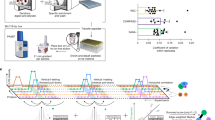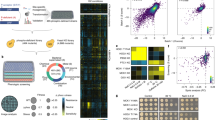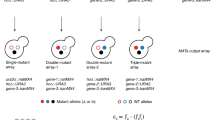Abstract
The array format for analyzing peptide and protein function offers an attractive experimental alternative to traditional library screens. Powerful new approaches have recently been described, ranging from synthetic peptide arrays to whole proteins expressed in living cells. Comprehensive sets of purified peptides and proteins permit high-throughput screening for discrete biochemical properties, whereas formats involving living cells facilitate large-scale genetic screening for novel biological activities. In the past year, three major genome-scale studies using yeast as a model organism have investigated different aspects of protein function, including biochemical activities, gene disruption phenotypes, and protein–protein interactions. Such studies show that protein arrays can be used to examine in parallel the functions of thousands of proteins previously known only by their DNA sequence.
This is a preview of subscription content, access via your institution
Access options
Subscribe to this journal
Receive 12 print issues and online access
$209.00 per year
only $17.42 per issue
Buy this article
- Purchase on Springer Link
- Instant access to full article PDF
Prices may be subject to local taxes which are calculated during checkout


Similar content being viewed by others
References
Debouck, C. & Goodfellow, P.N. DNA microarrays in drug discovery and development. Nat. Genet. 21(1 Suppl), 48–50 (1999).
Gerhold, D., Rushmore, T. & Caskey, C.T. DNA chips: promising toys have become powerful tools. Trends Biochem. Sci. 24, 168–173 (1999).
Botstein, D. & Cherry, J.M. Molecular linguistics: extracting information from gene and protein sequences. Proc. Natl. Acad. Sci. USA. 94, 5506–5507 (1997).
Pease, A.C. et al. Light-generated oligonucleotide arrays for rapid DNA sequence analysis. Proc. Natl. Acad. Sci. USA 91, 5022–5026 (1994).
Celis, J.E. & Gromov, P. 2D protein electrophoresis: can it be perfected? Curr. Opin. Biotechnol. 10, 16–21 (1999).
Quadroni, M. & James, P. Proteomics and automation. Electrophoresis 20, 664–677 (1999).
Andersen, J.S., Svensson, B. & Roepstorff, P. Electrospray ionization and matrix assisted laser desorption/ionization mass spectrometry: powerful analytical tools in recombinant protein chemistry. Nat. Biotechnol. 14, 449–457 (1996).
Bork, P. et al. Predicting function: from genes to genomes and back. J. Mol. Biol. 283, 707–725 (1998).
Marcotte, E.M., Pellegrini, M., Thompson, M.J., Yeates, T.O. & Eisenberg, D. A combined algorithm for genome-wide prediction of protein function. Nature 402, 83–86 (1999).
Lam, K.S. et al. A new type of synthetic peptide library for identifying ligand-binding activity. Nature 354, 82–84 (1991).
Houghten, R.A. et al. Generation and use of synthetic peptide combinatorial libraries for basic research and drug discovery. Nature 354, 84–86 (1991).
Geysen, H.M., Meloen, R.H. & Barteling, S.J. Use of peptide synthesis to probe viral antigens for epitopes to a resolution of a single amino acid. Proc. Natl. Acad. Sci. USA 81, 3998–4002 (1984).
Maeji, N.J. et al. Systematic screening for bioactive peptides. Pept. Res. 4, 142–146 (1991).
Gausepohl, H., Boulin, C., Kraft, M. & Frank, R.W. Automated multiple peptide synthesis. Pept. Res. 5, 315–320 (1992).
Kramer, A. & Schneider-Mergener, J. Synthesis and screening of peptide libraries on continuous cellulose membrane supports. Methods Mol. Biol. 87, 25–39 (1998).
Kramer, A., Volkmer-Engert, R., Malin, R., Reineke, U. & Schneider-Mergener, J. Simultaneous synthesis of peptide libraries on single resin and continuous cellulose membrane supports: examples for the identification of protein, metal and DNA binding peptide mixtures. Pept. Res. 6, 314–319 (1993).
Reineke, U. et al. Mapping protein-protein contact sites using cellulose-bound peptide scans. Mol. Divers. 1, 141–148 (1996).
Reuter, M. et al. Regions of endonuclease EcoRII involved in DNA target recognition identified by membrane-bound peptide repertoires. J. Biol. Chem. 274, 5213–5221 (1999).
Reineke, U. et al. A synthetic mimic of a discontinuous binding site on interleukin-10. Nat. Biotechnol. 17, 271–275 (1999).
Munch, G. et al. Amino acid specificity of glycation and protein-AGE crosslinking reactivities determined with a dipeptide SPOT library. Nat. Biotechnol. 17, 1006–1010 (1999).
Fodor, S.P. et al. Light-directed, spatially addressable parallel chemical synthesis. Science 251, 767–773 (1991).
Cwirla, S.E., Peters, E.A., Barrett, R.W. & Dower, W.J. Peptides on phage: a vast library of peptides for identifying ligands. Proc. Natl. Acad. Sci. USA. 87, 6378–6382 (1990).
Molina, F., Laune, D., Gougat, C., Pau, B. & Granier, C. Improved performances of spot multiple peptide synthesis. Pept. Res. 9, 151–155 (1996).
Ekins, R. & Chu, F. Immunoassay and other ligand assays: present status and future trends. J. Int. Fed. Clin. Chem. 9, 100–109 (1997).
Rowe, C.A. et al. Array biosensor for simultaneous identification of bacterial, viral, and protein analytes. Anal. Chem. 71, 3846–3852 (1999).
Silzel, J.W., Cercek, B., Dodson, C., Tsay, T. & Obremski, R.J. Mass-sensing, multianalyte microarray immunoassay with imaging detection. Clin. Chem. 44, 2036–2043 (1998).
Hutchens, T.W. & Yip, T-T. New desorption strategies for the mass spectrometric analysis of macromolecules. Rapid Commun. Mass Spectrom. 7, 576–580 (1993).
Frears, E.R., Stephens, D.J., Walters, C.E., Davies, H. & Austen, B.M. The role of cholesterol in the biosynthesis of beta-amyloid. Neuroreport 10, 1699–1705 (1999).
Bieri, C., Ernst, O.P., Heyse, S., Hofmann, K.P. & Vogel, H. Micropatterned immobilization of a G protein-coupled receptor and direct detection of G protein activation. Nat. Biotechnol. 17, 1105–1108 (1999).
Martzen, M.R. et al. A biochemical genomics approach for identifying genes by the activity of their products. Science 286, 1153–1155 (1999).
Oldenburg, K.R., Vo, K.T., Michaelis, S. & Paddon, C. Recombination-mediated PCR-directed plasmid construction in vivo in yeast. Nucleic Acids Res. 25, 451–452 (1997).
Zhang, Y., Buchholz, F., Muyrers, J.P. & Stewart, A.F. A new logic for DNA engineering using recombination in Escherichia coli. Nat. Genet. 20, 123–128 (1998).
Heyman, J.A. et al. Genome-scale cloning and expression of individual open reading frames using topoisomerase I-mediated ligation. Genome Res. 9, 383–392 (1999).
Nilsson, J., Stahl, S., Lundeberg, J., Uhlen, M. & Nygren, P.A. Affinity fusion strategies for detection, purification, and immobilization of recombinant proteins. Protein Expr. Purif. 11, 1–16 (1997).
Rigaut, G. et al. A generic protein purification method for protein complex characterization and proteome exploration. Nat. Biotechnol. 17, 1030–1032 (1999).
Uetz, P. et al. A comprehensive analysis of protein-protein interactions in Saccharomyces cerevisiae. Nature 403, 623–627 (2000).
Goffeau, A. et al. Life with 6000 genes. Science 274, 546, 563–567 (1996).
Wang, M.M. & Reed, R.R. Molecular cloning of the olfactory neuronal transcription factor Olf-1 by genetic selection in yeast. Nature 364, 121–126 (1993).
Sengupta, D.J., Wickens, M. & Fields, S. Identification of RNAs that bind to a specific protein using the yeast three-hybrid system. RNA 5, 596–601 (1999).
Belshaw, P.J., Ho, S.N., Crabtree, G.R. & Schreiber, S.L. Controlling protein association and subcellular localization with a synthetic ligand that induces heterodimerization of proteins. Proc. Natl. Acad. Sci. USA 93, 4604–4607 (1996).
Licitra, E.J. & Liu, J.O. A three-hybrid system for detecting small ligand-protein receptor interactions. Proc. Natl. Acad. Sci. USA 93, 12817–12821 (1996).
Ross-Macdonald, P. et al. Large-scale analysis of the yeast genome by transposon tagging and gene disruption. Nature 402, 413–418 (1999).
Mattheakis, L.C., Bhatt, R.R. & Dower, W.J. An in vitro polysome display system for identifying ligands from very large peptide libraries. Proc. Natl. Acad. Sci. USA 91, 9022–9026 (1994).
Roberts, R.W. & Szostak, J.W. RNA-peptide fusions for the in vitro selection of peptides and proteins. Proc. Natl. Acad. Sci. USA 94, 12297–12302 (1997).
Bier, F.F., Kleinjung, F., Ehrentreich-Forster, E. & Scheller, F.W. Changing functionality of surfaces by directed self-assembly using oligonucleotides–the oligo-tag. Biotechniques 27, 752–760 (1999).
Winzeler, E.A. et al. Functional characterization of the S. cerevisiae genome by gene deletion and parallel analysis. Science 285, 901–906 (1999).
Hunter, C.P. Genetics: a touch of elegance with RNAi. Curr. Biol. 9, R440–R442 (1999).
Pollok, B.A. & Heim, R. Using GFP in FRET-based applications. Trends Cell Biol. 9, 57–60 (1999).
Mazzola, L.T. & Fodor, S.P. Imaging biomolecule arrays by atomic force microscopy. Biophys. J. 68, 1653–1660 (1995).
Frederickson, R.M. Macromolecular matchmaking: advances in two-hybrid and related technologies. Curr. Opin. Biotechnol. 9, 90–96 (1998).
Acknowledgements
We thank Michael DeVit, Andrew Emili, Stanley Fields, Stephen McCraith, Eric Phizicky, Chandra Tucker, and Peter Uetz for comments on the manuscript, and Deborah Diamond for helpful suggestions. This work was supported by NIH grants GM54415 and RR11823 and a grant from the Merck Genome Research Institute. A.Q.E. is a research associate of the Howard Hughes Medical Institute.
Author information
Authors and Affiliations
Corresponding author
Rights and permissions
About this article
Cite this article
Emili, A., Cagney, G. Large-scale functional analysis using peptide or protein arrays. Nat Biotechnol 18, 393–397 (2000). https://doi.org/10.1038/74442
Received:
Accepted:
Issue Date:
DOI: https://doi.org/10.1038/74442
This article is cited by
-
Studies of mechanisms and characteristics of the fluorescence enhancement on anodic aluminum oxide thin film
Applied Nanoscience (2018)
-
Proteomic Analysis of Hepatic Tissue in Adult Female Zebrafish (Danio rerio) Exposed to Atrazine
Archives of Environmental Contamination and Toxicology (2012)
-
Novel concept microarray enabling PCR and multistep reactions through pipette-free aperture-to-aperture parallel transfer
BMC Biotechnology (2010)
-
High quality protein microarray using in situprotein purification
BMC Biotechnology (2009)



